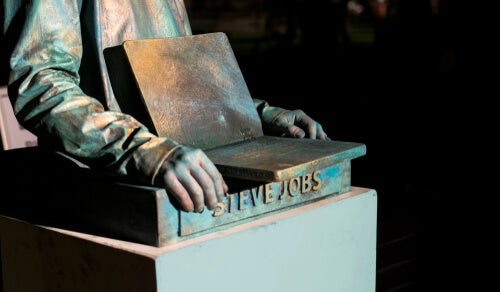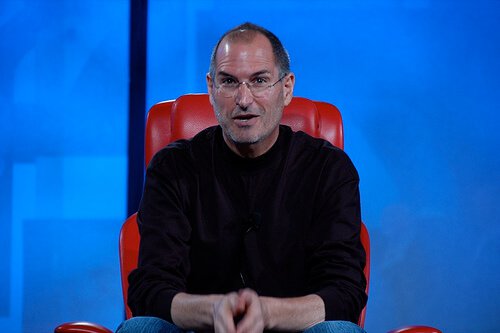Steve Jobs: Biography of the Man Who Invented the 21st Century

Creativity and absolute brilliance are, perhaps, the two words that come to mind when you think of Steve Jobs. Some say that he was the inventor of the 21st century. And this isn’t just a metaphor. The way people work, communicate, and engage with the world is mainly thanks to this genius.
He succeeded in business early in his career. Maybe that’s why he always said that no amount of success or money impressed him or motivated him to keep working. He simply made a dream come true. A dream that old ideas and big shareholder meetings took away from him. But Jobs never lost his visionary spirit. He never gave up.
Like many other highly creative people, Steve Jobs lived his life between success and frustration, between a new project (that no one had thought of before) and the pursuit of a more significant life.
Early years
Steve Jobs was born in San Francisco, California in 1955. His biological parents were two college students that gave him up for adoption at birth. Fortunately, little Steve found a family who encouraged and supported him.
He went to school in California and then moved to Portland to start college. His time at Reed College was significant, as he developed excellent qualities that contrasted his indifferent personality.

His spiritual quest
In 1974, Steve Jobs went on a trip to India to find a meaningful purpose for his life. He spent some time in the ashram of the Shri Neem Karoli Baba, in Kainchi. In fact, he studied Buddhism in a Zen center in Los Altos during the 70s. Jobs built a life-long friendship with his Zen master.
His biographers claim that Zen Buddhism changed his life and the way he worked. In 2005, Jobs said:
“For the past 33 years, I’ve looked in the mirror every morning and asked myself: “If today were the last day of my life, would I want to do what I’m about to do today?” And whenever the answer has been “No” for too many days in a row, I know I need to change something… almost everything – all external expectations, all pride, all fear of embarrassment or failure – these things just fall away in the face of death, leaving only what’s truly important. Remembering that you’re going to die is the best way I know to avoid the trap of thinking you have something to lose.”
During the 70s, Steve Jobs also joined his country’s Counterculture movement, where he experimented with psychedelic drugs. Jobs said that his time doing drugs was fundamental, as it put his own life into perspective and allowed him to visualize his future.
Steve Jobs and the first computers
His first computer job was in Atari, where he met Steve Wozniak, a computer technician who would later become Apple’s co-founder alongside Steve Jobs. They were the perfect duo. Wozniak’s intelligence as an engineer met Jobs’ business talent, which they used to create the project that would become an empire.
During the time they worked for Atari, computers were exclusive to big companies and cost more than a house. Wozniak built the first personal computer, as he wanted to have one at home. That’s when it all started.
Two visionaries started selling the first personal computer out of Steve Jobs’ parents’ house garage. Although they went separate ways after some time, they achieved amazing things together.
The adventure of Apple
In the following years, Apple computers expanded on the market. Apple shares went public and things became a bit complicated for Jobs.
In 1984, they designed the first Macintosh, an invention that made a great change in the computer industry. However, it didn’t sell as expected. Apple had become big and the executive board didn’t share Jobs’ vision nor passion.
They believed that Steve’s demanding and perfectionist attitude undermined his creativity and visionary skills. Like all brilliant people who’ve made history, Steve Jobs needed a team that worked with the same passion and vision.
Finally, in 1985, Wozniak left Apple. A year later, the board took away Steve Jobs’ executive duties, so he had no say over his own company’s future. Therefore, Jobs left Apple as well. That’s when he created Next and started participating in Pixar projects to produce animated films on computers. His time in Pixar led him to great success and allowed him to feel respect for his own work.

Back to Apple
Steve Jobs went back to Apple in 1996, a time in which the company was technologically behind Microsoft. Apple was nearly bankrupt but Steve’s come-back gave it a new direction. He cancelled all the ongoing projects and gained back control over his company. He made history all over again.
Jobs then designed a new generation of innovative products, such as the iPod, the iPad, and, of course, the iPhone. He established a standard for portable digital music.
In 2008, iTunes had more than six million downloads and more than 200 million iPods had sold. In 2010, Jobs introduced the iPad and the whole tablet system. Then, in 2012, Apple became the most valuable public company in the world.
During a 2007 interview, Jobs said:
“There’s an old Wayne Gretzky quote that I love. I skate to where the puck is going to be, not to where it has been. And we’ve always tried to do that at Apple. Since the very beginning. And we always will.”
Steve Jobs’ premature death
A perfectionist, passionate, and visionary human being. These traits were his angels and his demons.
In 2003, Steve Jobs was diagnosed with pancreatic cancer, which led to a series of health problems. Nevertheless, he kept working until 2009, the year in which his illness forced him to leave his job. He passed away in 2011, at the age of 56. He was buried in an unmarked grave in Palo Alto, California.
Steve Jobs thought of the slogan “Think different” when he got Apple back.
“Here’s to the crazy ones, the misfits, the rebels, the troublemakers, the round pegs in the square holes… the ones who see things differently — they’re not fond of rules… You can quote them, disagree with them, glorify or vilify them, but the only thing you can’t do is ignore them because they change things… they push the human race forward, and while some may see them as the crazy ones, we see genius, because the ones who are crazy enough to think that they can change the world, are the ones who do.”
-Steve Jobs-
All cited sources were thoroughly reviewed by our team to ensure their quality, reliability, currency, and validity. The bibliography of this article was considered reliable and of academic or scientific accuracy.
- Isaacson, W. (2011). Steve Jobs Biography. New York; Simon & Schuster
- Maslin, Janet (2011). Making the iBio for Apple’s Genius. New York Times 21 Oct 2011. Recuperado de https://www.nytimes.com/2011/10/22/books/steve-jobs-by-walter-isaacson-review.html
- Dhiman, Satinder (2016) “The Spiritual Quest of Steve Jobs: Connecting the i-dots Gazing Forward, Glancing Back,” The Journal of Values-Based Leadership: Vol. 9 : Iss. 2 , Article 13. Recuperado de: http://scholar.valpo.edu/jvbl/vol9/iss2/13
- Peterson, Christopher (2011). Learning from the Life of Steve Jobs, Psychology Today 01 Diciembre 2011. Recuperado de https://www.psychologytoday.com/us/blog/the-good-life/201112/learning-the-life-steve-jobs
This text is provided for informational purposes only and does not replace consultation with a professional. If in doubt, consult your specialist.








